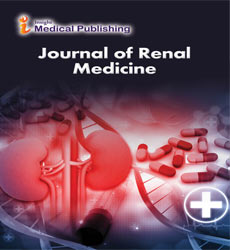Evaluation and Clinical Importance of Proteinuria
Josh Byrne*
Department of Medicine, University of Verona, Verona, Italy
- *Corresponding Author:
- Josh Byrne
Department of Medicine,
University of Verona, Verona,
Italy,
E-mail: Byrne.J@gmail.com
Received date: December 25, 2023, Manuscript No. IPJRM-24-18581; Editor assigned date: December 28, 2023, PreQC No. IPJRM-24-18581 (PQ); Reviewed date: January 11, 2024, QC No. IPJRM-24-18581; Revised date: January 18, 2024, Manuscript No. IPJRM-24-18581 (R); Published date: January 25, 2024, DOI: 10.36648/ipjrm.7.1.7
Citation: Byrne J (2024) Evaluation and Clinical Importance of Proteinuria. Jour Ren Med Vol. 7 No.1:07.
Description
Proteinuria is outcome of two systems, transglomerular entry of proteins expanded porousness of glomerular fine wall and their ensuing hindered reabsorption by the epithelial cells of the proximal tubuli. In the different glomerular sicknesses, the seriousness of disturbance of the underlying honesty of the glomerular fine wall connects with the region of the glomerular obstruction being penetrated by enormous pores, allowing the section in the cylindrical lumen of high atomic weight proteins, to which the hindrance is regularly impermeable. The expanded heap of such proteins in the rounded lumen prompts the immersion of the reabsorptive component by the cylindrical cells, and, in the most serious or ongoing circumstances, to their poisonous harm, that leans toward the expanded urinary discharge, everything being equal, including low atomic weight proteins, which are totally reabsorbed in physiologic circumstances.
Progressive Renal Damage
In spite of the very low protection from water stream, the glomerular narrow wall limits the section of proteins from the blood into bowman's space based on their sub-atomic size, electrical charge, and sterical setup. There is an agreement that the glomerular wall might be considered containing three boundaries in series. Along its course to this iltration obstruction, it initially needs to go through the open pores of the glomerular endothelium, then through the profoundly hydrated collagenous organization of the glomerular storm cellar a sub-atomic plat orm made out of cross-connected collagen, laminin, and proteoglycans, lastly, through the cuts laid out by interdigitations of podocyte foot processes and covered by an intricate construction called cut stomach, which is moored along the edges of the contiguous foot processes. The fenestrated endothelium can address an electrostatic obstruction for adversely charged proteins, and glomerular cellar layer with its laminae can cause the crossing of huge plasma proteins and adversely charged proteins because of the presence of heparan sulfate proteoglycans, ongoing proof proposes more particular hindrance for most of proteins lives in the cut diaphram. Notwithstanding, the sub-atomic sythesis of this last construction is still generally obscure.
Nephrin atoms stretching out toward one another from two adjoining foot processes are probably going to associate in the cut through homophilic cooperations and covalent crossconnecting. As of late, two different proteins have been found as parts of the cut stomach space of podocytes, which for its design presumably goes about as a connector connecting the actinbased cytoskeleton of podocyte to nephrin, and podocin, a stomatin like protein that structures totals and coordinates lipid pontoons. A complex of nephrin, podocin is arising as the utilitarian unit whereupon the cut stomach gathers. These proteins are irmly related and are installed into lipid pontoons. Podocin might be basic for the strength of this complex, its limiting decisively actuates the lagging capacities of nephrin. The basal part of podocytes is connected to the glomerular storm cellar layer through a few grip proteins. The dystoglycan complex most likely gives an actin coordinated situating framework by which podocytes movement control the speci ic dispersing of lattice proteins, and subsequently the porosity and porousness of the glomerular storm cellar ilm. Proteinuria is an exemplary indication of kidney sickness and its presence conveys strong prognostic data. In spite of the fact that proteinuria testing is revered in clinical practice rules, there is amazing variety among such rules regarding the meaning of clinically huge proteinuria. There is likewise unfortunate understanding regarding whether proteinuria ought to be characterized concerning egg whites or complete protein misfortune, with an alternate methodology being utilized to separate diabetic and non-diabetic nephropathy.
Proteinuria in Adults
Proteinuria is a typical inding in grown-ups in essential consideration practice. An algorithmic methodology can be utilized to separate harmless reasons for proteinuria from more extraordinary, serious problems. Harmless causes incorporate fever, extreme action or exercise, parchedness, pressure and intense sickness. More serious purposes incorporate glomerulonephritis and numerous myeloma. Basic, weaken or thought pee, gross hematuria, and the presence of bodily luid, semen or white platelets can make a dipstick urinalysis be dishonestly certain for protein. Of the three pathophysiologic instruments glomerular, cylindrical and lood that produce proteinuria, glomerular breakdown is the most widely recognized and as a rule compares to a urinary protein discharge of multiple g each 24 hours. At the point when a quantitative estimation of urinary protein is required, most doctors favor a 24 hour pee. Most patients assessed for proteinuria have a harmless reason. Patients with proteinuria more noteworthy in whom the hidden etiology stays hazy after an exhaustive clinical assessment ought to be alluded to a nephrologist.
Open Access Journals
- Aquaculture & Veterinary Science
- Chemistry & Chemical Sciences
- Clinical Sciences
- Engineering
- General Science
- Genetics & Molecular Biology
- Health Care & Nursing
- Immunology & Microbiology
- Materials Science
- Mathematics & Physics
- Medical Sciences
- Neurology & Psychiatry
- Oncology & Cancer Science
- Pharmaceutical Sciences
